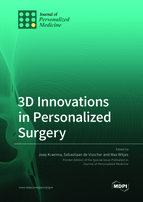3D Innovations in Personalized Surgery
A special issue of Journal of Personalized Medicine (ISSN 2075-4426).
Deadline for manuscript submissions: closed (15 August 2022) | Viewed by 7612
Special Issue Editors
Interests: 3D VSP; oncology; oral and maxillofacial surgery; A.I.; patient-specific implants; 3D; surgical navigation
Interests: 3D VSP; oncology; oral and maxillofacial surgery
Special Issue Information
Dear Colleagues,
Current practice involves the use of 3D surgical planning and patient-specific solutions in multiple surgical areas of expertise. Patient-specific solutions have been endorsed for several years in numerous publications due to their benefits around accuracy, safety, and predictability of surgical outcome. The basis of 3D surgical planning is the use of high-quality medical images (e.g., CT, MRI, or PET-scans). The translation from 3D digital planning toward surgical applications was developed hand in hand with a rise in 3D printing applications of multiple biocompatible materials. These technical aspects of medical care require engineers’ or technical physicians’ expertise for optimal safe and effective implementation in daily clinical routines.
Currently, we are working toward the next generation of personalized surgery, in which we combine the use of new materials and optimized 3D printing technology for medical devices. The use of artificial intelligence and augmented reality enable optimized 3D virtual surgical planning and its translation toward the surgical procedure. In addition, we can also incorporate, next to anatomical information, biomechanical aspects into personalized implants and devices.
The aim and scope of this Special Issue is high-tech solutions in personalized surgery, based on 3D technology and, more specifically, bone-related surgery. Full-papers or highly innovative technical notes or (systematic) reviews that relate to innovative personalized surgery are invited. This can include optimization of imaging for 3D VSP, optimization of 3D VSP workflow and its translation toward the surgical procedure, or optimization of personalized implants or devices in relation to bone surgery.
Dr. Joep Kraeima
Dr. Sebastiaan de Visscher
Prof. Dr. Max J.H. Witjes
Guest Editors
Manuscript Submission Information
Manuscripts should be submitted online at www.mdpi.com by registering and logging in to this website. Once you are registered, click here to go to the submission form. Manuscripts can be submitted until the deadline. All submissions that pass pre-check are peer-reviewed. Accepted papers will be published continuously in the journal (as soon as accepted) and will be listed together on the special issue website. Research articles, review articles as well as short communications are invited. For planned papers, a title and short abstract (about 100 words) can be sent to the Editorial Office for announcement on this website.
Submitted manuscripts should not have been published previously, nor be under consideration for publication elsewhere (except conference proceedings papers). All manuscripts are thoroughly refereed through a single-blind peer-review process. A guide for authors and other relevant information for submission of manuscripts is available on the Instructions for Authors page. Journal of Personalized Medicine is an international peer-reviewed open access monthly journal published by MDPI.
Please visit the Instructions for Authors page before submitting a manuscript. The Article Processing Charge (APC) for publication in this open access journal is 2600 CHF (Swiss Francs). Submitted papers should be well formatted and use good English. Authors may use MDPI's English editing service prior to publication or during author revisions.
Keywords
- 3D VSP
- patient-specific
- implants
- oral and maxillofacial surgery
- guided surgery
- orthopedics
- trauma surgery
- neurosurgery









